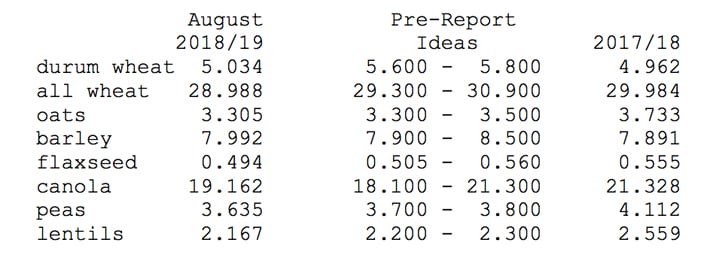WINNIPEG – A summer of dryness and sizzling heat has apparently taken its toll on canola plants in many areas of Western Canada, according to the latest crop production estimate by Statistics Canada.
In a survey that was compiled in the latter days of July, Statistics Canada pegged canola production for 2018/19 at 19.2 million tonnes, which was lower than what most traders were expecting. It would also be down sharply from last year’s total of 21.3 million tonnes.
“It’s certainly on the light side,” said Mike Jubinville of ProFarmer Canada, which is owned by Glacier FarmMedia. “But with harvest just getting underway, I suspect we will see a bigger number in subsequent reports.”
Read Also

Farming Smarter receives financial boost from Alberta government for potato research
Farming Smarter near Lethbridge got a boost to its research equipment, thanks to the Alberta government’s increase in funding for research associations.
The next report traders will be watching for is a computer-based model, also compiled by Statistics Canada, which is due on Sept. 19.
A trader in Winnipeg agreed yield numbers could rise in that report, adding there are noticeable differences between crop quality in the southern Prairies and the north.
“Yields in the south are coming in below expectations, as you move further north they’re higher,” said Keith Ferley of RBC Dominion Markets.
The estimate for Canadian all-wheat came in at 28.9 million tonnes, which was on the lower side of trade guesses.
Jubinville suspects that number could also grow.
“Spring wheat could be one million or two million tonnes higher,” he explained.
Estimates for durum came in around five million tonnes, slightly higher than last year’s production.
As expected, the forecast for pulse production was down significantly from last year. Pea production was pegged at 3.6 million tonnes while lentils were 2.2 million tonnes.
According to Bruce Burnett of Glacier Farm Media, the lower forecast could help the supply and demand balance sheets for both crops.
Barley production is expected to be higher. According to Statistics Canada, production this year will hit just under eight million tonnes.
“It’s suggestive of a tight barley supply situation that is evolving for new crop marketing year,” said Jubinville.
In the near-term, harvest pressure is expected to keep upward price action muted, but once the crop is in the bin today’s forecast should be supportive for prices in general.
The following is a quick summary of the Statistics Canada crop production estimates for 2018/19. Pre-report estimates are included for comparison.
Production in million metric tons. Source: Statistics Canada.


















